DATAPATH
The CPU can be divided into a data section and a control section. The data section, which is also called the datapath, contains the registers and the ALU. The datapath is capable of performing certain operations on data items. The control section is basically the control unit, which issues control signals to the datapath. Internal to the CPU, data move from one register to another and between ALU and registers. Internal data movements are performed via local buses, which may carry data, instructions, and addresses. Externally, data move from registers to memory and I/O devices, often by means of a system bus. Internal data movement among registers and between the ALU and registers may be carried out using different organizations including one-bus, two-bus, or three-bus organizations. Dedicated datapaths may also be used between components that transfer data between themselves more frequently. For example, the contents of the PC are transferred to the MAR to fetch a new instruction at the beginning of each instruction cycle.
7.1. One-Bus Organization
Using one bus, the CPU registers and the ALU use a single bus to move outgoing and incoming data. Since a bus can handle only a single data movement within one clock cycle, two-operand operations will need two cycles to fetch the operands for the ALU. Additional registers may also be needed to buffer data for the ALU. This bus organization is the simplest and least expensive, but it limits the amount of data transfer that can be done in the same clock cycle, which will slow down the overall performance. Figure 7 shows a one-bus datapath consisting of a set of general-purpose registers, a memory address register (MAR), a memory data register (MDR), an instruction register (IR), a program counter (PC), and an ALU.
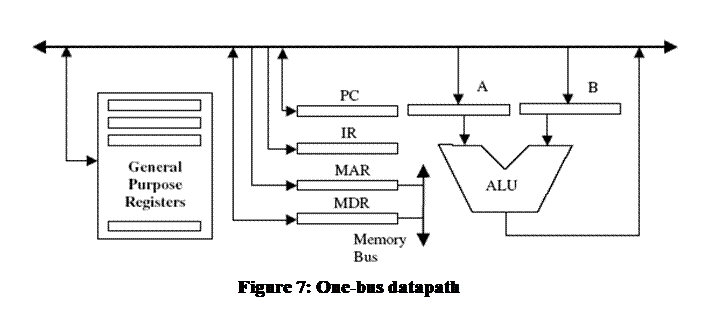
7.2. Two-Bus Organization
Using two buses is a faster solution than the one-bus organization. In this case, general-purpose registers are connected to both buses. Data can be transferred from two different registers to the input point of the ALU at the same time. Therefore, a two operand operation can fetch both operands in the same clock cycle. An additional buffer register may be needed to hold the output of the ALU when the two buses are busy carrying the two operands. Figure 8a shows a two-bus organization. In some cases, one of the buses may be dedicated for moving data into registers (in-bus), while the other is dedicated for transferring data out of the registers (out-bus). In this case, the additional buffer register may be used, as one of the


7.3. Three-Bus Organization
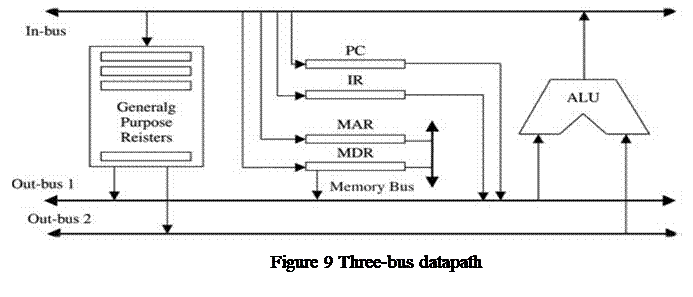 In a three-bus organization, two buses may be used as source buses while the third is used as destination. The source buses move data out of registers (out-bus), and the destination bus may move data into a register (in-bus). Each of the two out-buses is connected to an ALU input point. The output of the ALU is connected directly to the in-bus. As can be expected, the more buses we have, the more data we can move within a single clock cycle. However, increasing the number of buses will also increase the complexity of the hardware. Figure 9 shows an example of a three-bus datapath.
In a three-bus organization, two buses may be used as source buses while the third is used as destination. The source buses move data out of registers (out-bus), and the destination bus may move data into a register (in-bus). Each of the two out-buses is connected to an ALU input point. The output of the ALU is connected directly to the in-bus. As can be expected, the more buses we have, the more data we can move within a single clock cycle. However, increasing the number of buses will also increase the complexity of the hardware. Figure 9 shows an example of a three-bus datapath.
8. CPU INSTRUCTION CYCLE
The sequence of operations performed by the CPU during its execution of instructions is presented in Fig. 10. As long as there are instructions to execute, the next instruction is fetched from main memory. The instruction is executed based on the operation specified in the opcode field of the instruction. At the completion of the instruction execution, a test is made to determine whether an interrupt has occurred. An interrupt handling routine needs to be invoked in case of an interrupt.
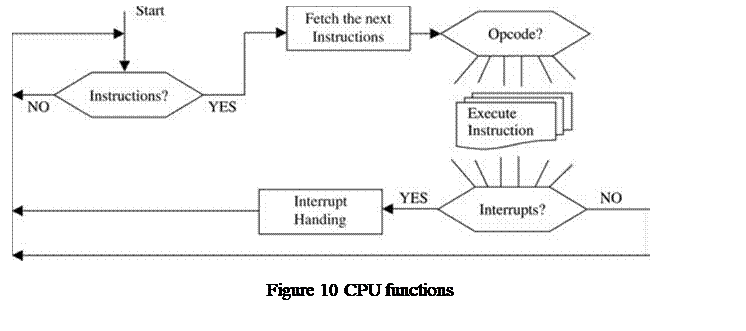
The basic actions during fetching an instruction, executing an instruction, or handling an interrupt are defined by a sequence of micro-operations. A group of control signals must be enabled in a prescribed sequence to trigger the execution of a microoperation. In this section, we show the micro-operations that implement instruction fetch, execution of simple arithmetic instructions, and interrupt handling.
8.1. Fetch Instructions
The sequence of events in fetching an instruction can be summarized as follows:
1. The contents of the PC are loaded into the MAR.
2. The value in the PC is incremented. (This operation can be done in parallel with a memory access.)
3. As a result of a memory read operation, the instruction is loaded into the MDR.
4. The contents of the MDR are loaded into the IR.
Let us consider the one-bus datapath organization shown in Fig. 7. We will see that the fetch operation can be accomplished in three steps as shown in the table below, where t0 < t1 < t2 . Note that multiple operations separated by “;” imply that they are accomplished in parallel.

Using the three-bus datapath shown in Figure 9, the following table shows the
steps needed.
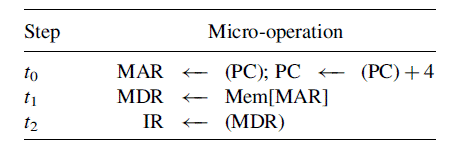
8.2. Execute Simple Arithmetic Operation
Add R1, R2, R0 This instruction adds the contents of source registers R1 and R2, and
stores the results in destination register R0. This addition can be executed as follows:
1. The registers R0 , R1 , R2 , are extracted from the IR.
2. The contents of R1 and R2 are passed to the ALU for addition.
3. The output of the ALU is transferred to R0 .
Using the one-bus datapath shown in Figure 7, this addition will take three steps as shown in the following table, where t0 < t1 < t2 .
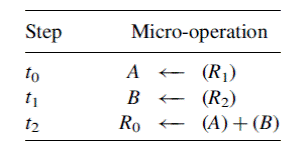
Using the two-bus datapath shown in Figure 8a, this addition will take two steps as shown in the following table, where t0 < t1 .
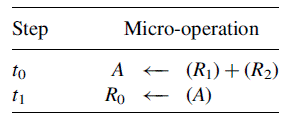
Using the two-bus datapath with in-bus and out-bus shown in Figure 8b, this addition will take two steps as shown below, where t0 < t1 .

Using the three-bus datapath shown in Figure 9, this addition will take only one
step as shown in the following table.

8.3. Interrupt Handling
After the execution of an instruction, a test is performed to check for pending interrupts.
If there is an interrupt request waiting, the following steps take place:
1. The contents of PC are loaded into MDR (to be saved).
2. The MAR is loaded with the address at which the PC contents are to be saved.
3. The PC is loaded with the address of the first instruction of the interrupt handling routine.
4. The contents of MDR (old value of the PC) are stored in memory.
The following table shows the sequence of events, where t1 < t2 < t3 .

9. CONTROL UNIT
The control unit is the main component that directs the system operations by sending control signals to the datapath. These signals control the flow of data within the CPU and between the CPU and external units such as memory and I/O. Control buses generally carry signals between the control unit and other computer components in a clock-driven manner. The system clock produces a continuous sequence of pulses in a specified duration and frequency. A sequence of steps t0 , t1 , t2 , . . . , (t0 < t1 < t2 , . . .) are used to execute a certain instruction.
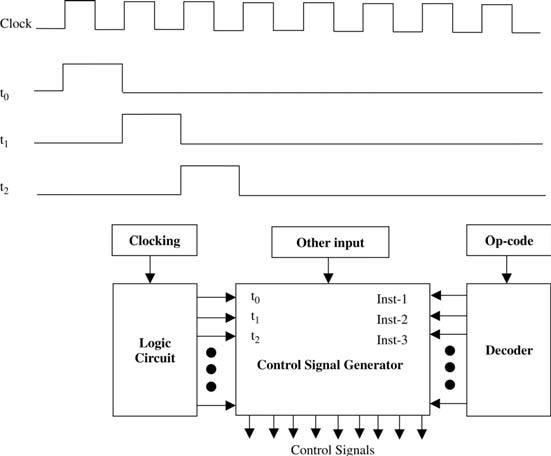
Figure 11 Timing of control signals
The op-code field of a fetched instruction is decoded to provide the control signal generator with information about the instruction to be executed. Step information generated by a logic circuit module is used with other inputs to generate control signals. The signal generator can be specified simply by a set of Boolean equations for its output in terms of its inputs. Figure 11 shows a block diagram that describes how timing is used in generating control signals.
There are mainly two different types of control units: microprogrammed and hardwired. In microprogrammed control, the control signals associated with operations are stored in special memory units inaccessible by the programmer as control words. A control word is a microinstruction that specifies one or more microoperations. A sequence of microinstructions is called a microprogram, which is stored in a ROM or RAM called a control memory CM.
In hardwired control, fixed logic circuits that correspond directly to the Boolean expressions are used to generate the control signals. Clearly hardwired control is faster than microprogrammed control. However, hardwired control could be very expensive and complicated for complex systems. Hardwired control is more economical for small control units. It should also be noted that microprogrammed control could adapt easily to changes in the system design. We can easily add new instructions without changing hardware. Hardwired control will require a redesign of the entire systems in the case of any change.
Source: http://www.uobabylon.edu.iq/eprints/pubdoc_11_27657_37.doc
Web site to visit: http://www.uobabylon.edu.iq
Author of the text: indicated on the source document of the above text
If you are the author of the text above and you not agree to share your knowledge for teaching, research, scholarship (for fair use as indicated in the United States copyrigh low) please send us an e-mail and we will remove your text quickly. Fair use is a limitation and exception to the exclusive right granted by copyright law to the author of a creative work. In United States copyright law, fair use is a doctrine that permits limited use of copyrighted material without acquiring permission from the rights holders. Examples of fair use include commentary, search engines, criticism, news reporting, research, teaching, library archiving and scholarship. It provides for the legal, unlicensed citation or incorporation of copyrighted material in another author's work under a four-factor balancing test. (source: http://en.wikipedia.org/wiki/Fair_use)
The information of medicine and health contained in the site are of a general nature and purpose which is purely informative and for this reason may not replace in any case, the council of a doctor or a qualified entity legally to the profession.
The texts are the property of their respective authors and we thank them for giving us the opportunity to share for free to students, teachers and users of the Web their texts will used only for illustrative educational and scientific purposes only.
All the information in our site are given for nonprofit educational purposes